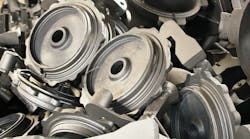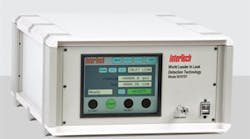Trying to eliminate defects in cast components involves a variety of testing applications, scanning processes, or use of specific additives during the process, just to name a few options. One particular type of defect — leaks in the component – has been addressed by InterTech Development Co.
Except in the rare applications for leak testing or functional testing, where the test tolerances are very loose, the way in which fixtures are designed and built can determine the effectiveness of a testing solution. Reliable and reproducible gauges usually require custom fixtures, given the unlimited variety of geometrics in parts that are tested.
At InterTech’s applications lab, engineers apply their extensive knowledge on fixture design, not only to develop fixtures that meet required gauge repeatability and reproducibility (R&R), but also to do so at the lowest cost.
Recently, InterTech’s leak-testing program was used at an automotive plant where oil pans were cast. The large volume castings, ranging from 11 to 24 liters, are cast, machined, and shipped. However, they must be tested to limits as low as 5 sccm in the shortest time possible.
The M1075-34Y mass flow leak detector — part of the M1075 series of mass flow leak test instruments — quickly tests large volume cast parts, such as oil pans, with InterTech’s patented superior mass flow sensors. One M1075-34Y leak detector runs three sequential tests of a 4.4-liter engine oil pan assembly to a 10.0 sccm leak limit, with manual clamping and sealing. The body (19-liter volume) is tested at 0.5 bar, with an optimized test time of 65 seconds. The mini sump (2.2 liter volume) is tested at 1 bar with an optimized test time of 18 seconds. The shaft bore is tested as well, at 0.5 bar with an optimized test time of 18 seconds.
Another 4.4-liter engine oil pan body casting (18.7-liter volume) is tested at 0.5 bar, to a 10.0 sccm leak limit, with a 30 second optimized test time. In automated plants, InterTech’s hydraulic power clamps are combined with M1075-34Y leak testers to accelerate production throughout, with improved ergonomics.
A machined oil pan casting (approx. 11-liters volume) is tested at 5 psig to a 5.0 sccm leak limit at the rate of 120 parts/hour. And, a 6.4-liter engine oil pan machined casting is tested sequentially. The body (24 liter volume) is tested at 1.0 bar to a 10.0 sccm leak limit, with a 35-second test time. The coolant circuit (2.2 liter volume) is tested at 1.5 bar to a 1.5 sccm leak limit.
All of these leak tests must handle all kinds of constraints — tight test limits, varying labor/automation scenarios, large volumes — and must be done in a cost-effective manner. They also need to meet 10% gauge R&R requirements.










